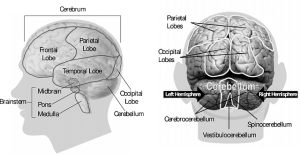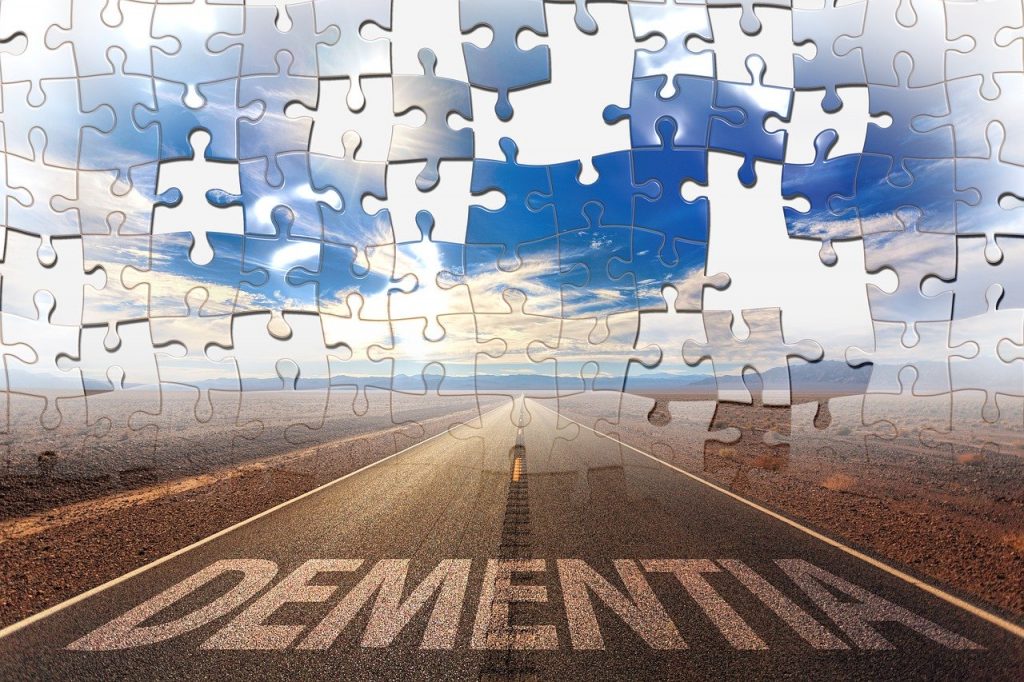This is part 3 of Kathy Lawrence’s series on Dementia and we will review the remaining 3 of the 5 different types of Alzheimer’s. View Part 1 Dementia – What is it? here and Part 2 Types of Dementia here.—EH Stafford, Managing Editor
Lewy Body Dementia (LBD)
The National Institute on Aging describes LBD as “a disease associated with abnormal deposits of a protein called Alpha-synuclein in the brain and these are called Lewy Bodies.” These deposits affect the brain’s function therefore causing dementia with varying symptoms and can be very hard to diagnose.
There are 2 versions: Dementia with Lewy Bodies and Parkinson’s dementia
 Dementia with Lewy Bodies is a progressive disease like Alzheimer’s starting slowly and worsening over time. The distinguishing factors in LBD is that person will develop motor control issues that mimic Parkinson’s disease such as a shuffling gait pattern. People also may hallucinate, and they exhibit more behavioral changes than the other forms of dementia.
Dementia with Lewy Bodies is a progressive disease like Alzheimer’s starting slowly and worsening over time. The distinguishing factors in LBD is that person will develop motor control issues that mimic Parkinson’s disease such as a shuffling gait pattern. People also may hallucinate, and they exhibit more behavioral changes than the other forms of dementia.
Another unique symptom of LBD is that a person will have fluctuations in their cognition. One minute a person can be alert and oriented to their surroundings, having normal conversations with family members, and then they can become lethargic, unclear and even illogical at times. These cognitive changes are usually what help distinguish it from an Alzheimer’s diagnosis. These changes can be very confusing for family members.
Mixed Dementia
The Alzheimer’s association states that mixed dementia is “a condition in which abnormalities, characteristic of more than one type of dementia, occur simultaneously. Physicians may also call mixed dementia “dementia – multifactorial.”
Simply stated, this is when a person has multiple versions of dementia at the same time. Most commonly, people will have Alzheimer’s dementia as well as vascular dementia.
With mixed dementia, progression and symptoms are varied. It is much harder to predict than other dementias and more challenging for family members to understand.
Frontotemporal Dementia (FTD)
 Frontotemporal dementia used to be called Pick’s disease although some will still use this term today. The Alzheimer’s association states that “Frontotemporal dementia (FTD) or frontotemporal degenerations refers to a group of disorders caused by progressive nerve cell loss in the brain’s frontal lobes (the areas behind your forehead) or its temporal lobes (the regions behind your ears).”
Frontotemporal dementia used to be called Pick’s disease although some will still use this term today. The Alzheimer’s association states that “Frontotemporal dementia (FTD) or frontotemporal degenerations refers to a group of disorders caused by progressive nerve cell loss in the brain’s frontal lobes (the areas behind your forehead) or its temporal lobes (the regions behind your ears).”
This type of dementia is known most for the behavioral changes, personality changes, and difficulties with communication that occur due to damage to the frontal and temporal lobes. Generally speaking, people will keep their physical functions.
Another distinguishing factor is the age of diagnosis. Most people are diagnosed between 40-60 years old. And, unlike others forms of dementia, hallucinations and delusions are uncommon.
This type of dementia has no known risk factors except a family history, as it is an inherited form of dementia. It is also the only form of dementia that cannot be prevented due to a lack of knowledge in risk factors.
My next article will discuss the different types of treatment for dementia.
References:
- https://www.alz.org/alzheimers-dementia/what-is-alzheimers
- https://www.mayoclinic.org/diseases-conditions/vascular-dementia/symptoms-causes/syc-20378793
- https://www.nia.nih.gov/health/what-lewy-body-dementia
- https://www.alz.org/alzheimers-dementia/what-is-dementia/types-of-dementia/mixed-dementia
- https://www.alz.org/alzheimers-dementia/what-is-dementia/types-of-dementia/frontotemporal-dementia
- https://www.nia.nih.gov/health/alzheimers-disease-fact-sheet

Kathy Lawrence has 20 years of experience as a Physical Therapist. Kathy received her Master of Physical Therapy degree in 1999 from the University of Wisconsin – Madison. Then followed up with her Doctorate Degree in Physical Therapy in 2008 from A.T. Still University. She prides herself in her focus on Healthy Aging. Whether it’s wellness, pain management, or helping recover from an injury Kathy has been instrumental in keeping our aging population on their feet.
The views, thoughts and opinions expressed by our writers
belong solely to them and do not represent
LKNConnect.com, its publisher or its staff.



